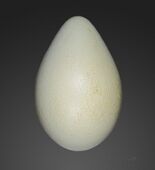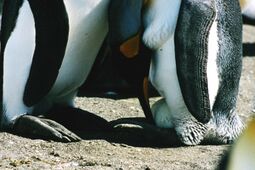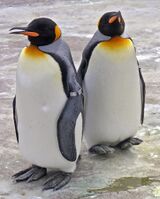Biology:Aptenodytes
From HandWiki
Short description: Genus of birds
| Aptenodytes Temporal range: Pliocene to recent[1]
| |
|---|---|
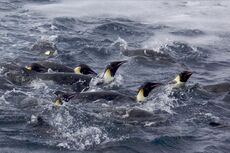
| |
| Emperor penguins swimming | |
| Scientific classification | |
| Domain: | Eukaryota |
| Kingdom: | Animalia |
| Phylum: | Chordata |
| Class: | Aves |
| Order: | Sphenisciformes |
| Family: | Spheniscidae |
| Genus: | Aptenodytes Miller, JF, 1778 |
| Type species | |
| Aptenodytes patagonicus | |
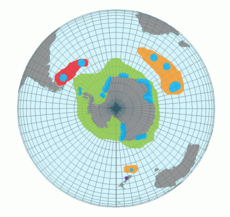
| |
Aptenodytes p. patagonicus
Aptenodytes patagonicus halli
Aptenodytes forsteri
Aptenodytes ridgeni (fossil)
breeding grounds
| |
The genus Aptenodytes contains two extant species of penguins collectively known as "the great penguins".[2]
Etymology
The name "Aptenodytes" is a composite of Ancient Greek elements, "ἀ-πτηνο-δύτης" (without-wings-diver).[3]
Taxonomy
- King penguin, Aptenodytes patagonicus
- Aptenodytes patagonicus patagonicus
- Aptenodytes patagonicus halli
- Emperor penguin, Aptenodytes forsteri
- Ridgen's penguin (Aptenodytes ridgeni) is an extinct species known from fossil bones of Early or Late Pliocene age.
Combined morphological and molecular data[4] have shown the genus Aptenodytes to be basal to all other living penguins, that is, the genus split off from a branch which led to all other species. DNA evidence suggests this split occurred around 40 million years ago.[5] This had been foreshadowed by an attempt to classify penguins by their behavior, which also predicted the genus' basal nature.[6]
The egg of a king penguin (10 cm, c. 300 g) and that of an emperor penguin (11.1–12.7 cm, 345–515 g).[7] At right a king penguin pair is changing the egg guard at South Georgia Island, where over 30 colonies of king penguin reside. An important cause for reproductive failure in some penguin species is mistiming between parents for incubation relief.[7]
Species
Two monotypic species are extant:[8]
| Aptenodytes | |||
|---|---|---|---|
| Common and binomial names[8] | Image | Description | Range |
| Emperor penguin (Aptenodytes forsteri) |
122 cm (4 ft) tall, weighing 22–37 kg (48.5–82 lb), the adult has deep black dorsal feathers, covering: the head, chin, throat, back, dorsal part of the flippers and tail. The underparts of the wings and belly are white, becoming pale yellow in the upper breast, and ear patches are bright yellow. The upper mandible is black and the lower mandible can be pink, orange or lilac. Males and females are similar in size and colouration. | Circumpolar distribution in the Antarctic between the 66° and 77° S. It almost always breeds on stable pack ice near the coast and wander up to 18 km (11 mi) offshore.[9] | |
| King penguin (Aptenodytes patagonicus) |
90 cm (3 ft) tall, weighing 11 to 16 kg (24 to 35 lb), The upper parts are steel blue-grey, darkening to black on the head, the belly is white fading to orange on the upper breast with bright orange ear patches. The black bill is long and slender. The lower mandible bears a striking pink or orange-coloured mandibular plate | Breeds on the subantarctic islands between 45° and 55° S at the northern reaches of Antarctica, as well as Tierra del Fuego, the Falkland Islands and other temperate islands of the region. | |
References
File:Aptenodytes patagonica (King Penguin).tif
- ↑ Gill, B.J. (2010). Checklist of the Birds of New Zealand, Norfolk and Macquarie Islands, and the Ross Dependency, Antarctica (Fourth ed.). Wellington: Te PaPa Press. pp. 330. ISBN 978-1-877385-59-9.
- ↑ DeNapoli, Dyan (2010). The Great Penguin Rescue. New York, NY: Simon & Schuster. p. 283. ISBN 978-1-4391-4817-4. https://books.google.com/books?id=DAyFQwlrKa4C&pg=PA283.
- ↑ "British Museum - King penguin". 2008-08-05. https://www.britishmuseum.org/explore/highlights/highlight_objects/loan_in/k/king_penguin.aspx.
- ↑ Ksepka, D. T. B.; Sara Giannini; Norberto P. (2006). "The phylogeny of the living and fossil Sphenisciformes (penguins)". Cladistics 22 (5): 412–441. doi:10.1111/j.1096-0031.2006.00116.x.
- ↑ "Multiple gene evidence for expansion of extant penguins out of Antarctica due to global cooling". Proc Biol Sci 273 (1582): 11–17. 2006. doi:10.1098/rspb.2005.3260. PMID 16519228.
- ↑ Jouventin P (1982). "Visual and vocal signals in penguins, their evolution and adaptive characters". Adv. Ethol. 24: 1–149.
- ↑ 7.0 7.1 "Penguins: Reproduction". SeaWorld Parks & Entertainment, Inc.. 2020. https://seaworld.org/animals/all-about/penguins/reproduction/.
- ↑ 8.0 8.1 "Zoological Nomenclature Resource: Ciconiiformes (Version 9.004)". www.zoonomen.net. 2008-07-05. http://www.zoonomen.net/avtax/cico.html.
- ↑ University of Michigan Museum of Zoology. "Aptenodytes forsteri". http://animaldiversity.ummz.umich.edu/site/accounts/information/Aptenodytes_forsteri.html.
External links
Wikidata ☰ Q652976 entry
 |

